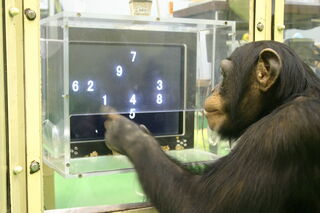Resilience
How to Inoculate Kids Against Failure
To succeed, Biden's education plan needs to learn from this chimpanzee research.
Posted April 28, 2021 Reviewed by Davia Sills
Key points
- The Kyoto University Primate Research Institute, where chimpanzees are the students, can serve as a model for how to revolutionize our schools.
- We could start by rewarding curiosity, autonomy, and hard work and prioritizing individual learning over standardized testing.
- With the help of technology, educators can allow children to go at their own pace without punishing or publicly shaming them.

As a Plexiglas enclosure opens, a chimpanzee rushes over to get to “school.” This is where the chimpanzees at the Kyoto University Primate Research Institute (PRI) learn math, language symbols, and how to stretch their memories. Within moments, a second chimpanzee arrives. Discouraged to find the classroom occupied, he hangs around anyway until a gentle thwack from the speedier pupil sends him off. The victorious chimp initiates a touchscreen-based lesson.
The chimpanzees attend their study sessions voluntarily (with no consequences for skipping class) and race for the chance at extra lessons (chimpanzee “homework”), enabling scientists like Professor Tetsuro Matsuzawa, who has worked with chimpanzees for over 40 years, to study their cognition.
The pandemic spurred the emergency adoption of distance learning, but our children—unlike these chimps—are sick of sitting in front of screens, and many parents worry their children are falling behind. This is not the fault of beleaguered educators teaching their hearts out or the inevitable result of computer-mediated lessons—it is the result of poor program design.
President Biden wants to inject hundreds of billions of dollars into public education—but instead of doubling down on our outdated school systems, we need a research-driven transformation in teaching comparable to the mRNA transformation of vaccine development. Prof. Matsuzawa’s school for chimpanzees can provide the foundation for that educational Operation Warp Speed. We must end our pandemic of failing schools and finally set all our students on the path to success as motivated, self-confident learners empowered to reach their full potential.
Prof. Matsuzawa explains the chimpanzees’ eager cooperation very simply: Good things happen predictably at “school,” including promptly delivered food rewards for correct answers (with some bonus snacks just for showing up). The chimps come not because they are hungry or bored but because they enjoy it.
Prof. Matsuzawa learned what “good things” would make his lessons appealing by observing wild chimps in Bossou-Nimba, Guinea. Study sessions at PRI mirror the schedule and rhythm of wild chimpanzees’ excursions to pluck and eat berries. Prof. Matsuzawa broke the curriculum into bite-sized pieces, enabling chimpanzees to figure out how to solve increasingly complex problems without becoming so confused and frustrated that they quit.
This approach appeals to innate chimpanzee motivations: to actively gather sustenance, master skills, complete tasks, please trusted companions, and imitate more skilled elders. Humans are far more social and more specialized for problem-solving and flexible thinking than chimpanzees. So if the PRI’s chimps rush to practice literacy and numeracy skills with no practical use, why would so many human children rather be homeschooled or home sick than in a classroom?
Because, unlike Prof. Matsuzawa’s program, our schools don’t adequately capitalize on innate motivations or respect natural rhythms. What would a school for humans look like if we based it on the inclinations of children “in the wild”?
1. Work should be rewarded.
Like adults who work for money or chimps who work for fruit, we should offer children meaningful rewards for schoolwork. We should provide healthy, tasty breakfasts, lunches, and snacks just for showing up, like leading tech companies that recruit and retain top-tier employees (and keep them at the office longer) by leveraging the profound appeal of a free, well-stocked snack bar and comfy break areas. Schools should follow suit, becoming a source of real pleasure and abundance instead of serving sad simulacrums of what children actually like.
2. Increase and personalize feedback.
Unlike chimps in a PRI research session, schoolchildren receive feedback only at a considerable delay (after time taken by the teacher for grading) or not at all (if another student is called on first). Instead, students should receive a tablet or computer and headphones to be kept at school and personalized tasks to complete each day independently. Computers give immediate aural and visual feedback, facilitating learning by altering brains.
They could help students stay organized and on-task, tracking assignment completion and reminding children about nearly due or overdue tasks.
Using screens in this way would also support teachers. Instead of supervising and grading large groups, teachers could electronically monitor each student’s progress in real-time, enabling them to provide individualized support and encouragement. Master teachers agree that personalized instruction is most effective, but our schools don’t provide adequate time for this.
3. Inspire curiosity, autonomy, and discovery.
Unlike chimps puzzling out new skills using their own wits and experimentation, in human classes, teachers explain the answers and how to find them. This makes children passive recipients, rather than active, autonomous participants, proudly mastering skills. Students’ lack of control over what they do, when, how, or at what pace undermines confidence and diminishes the pleasure of discovery.
Well-designed educational software could break lessons into small enough chunks that students could figure them out by themselves, like a video game adding complexity with each level. If making progress in Candy Crush compels millions of adults to spend endless hours matching colored shapes, imagine how intensely motivational the social and intellectual rewards of succeeding at school could be.
4. End testing.
The $1.7 billion spent annually on testing would be unnecessary because computers would provide real-time data about accomplishment to students, teachers, administrators, and government agencies, offering richer and more accurate metrics. This would protect children from the stress of annual tests and keep class time devoted to learning.
The savings should be used to develop suites of games that develop critical thinking, analytic, and academic skills. These should be built around themes children find deeply interesting and be just as addictively exciting and rewarding as the games children try to sneak while pretending to do Zoom school.
Like an mRNA vaccine that can be quickly and rapidly reformulated to attack different viruses or variants, such programs could be tailored to deliver an almost unlimited variety of educational material at the rate and in the form most likely to excite individual learners.
5. Everyone can go at their own pace—in the same classroom.
Students should work autonomously for the length of their individual attention spans, taking natural breaks before refocusing. A student who needs 5 minutes to complete a math assignment but 20 minutes for a reading comprehension assignment, and one who is the opposite, could each spend their time accordingly, rather than feeling bored with one task or rushed and frustrated by the other.
This approach builds on what educators and educational psychologists have known for over a century: Educational tasks must be both inherently interesting and not too easy or hard to create eager learners. Teachers could select assignments suited to each child’s interests and abilities, so children of all academic, economic, and cultural backgrounds could learn in the same classroom. This would end segregation into “ability” groups, reducing inequality.
6. Turn screens off (sometimes).
The skills and abilities developed on computers would be supplemented by real-world experiences, like growing plants, playing musical instruments, performing lab experiments, and group interactions that develop verbal and social skills.
7. Bad things shouldn’t happen in school.
This is so basic that for Prof. Matsuzawa, it went without saying—but we need to spell it out.
Unlike in the chimps’ classes, where the consequence of a wrong answer is simply a buzzer, lack of food reward, and frustration, the consequences for children include humiliation, losing confidence, and disappointing teachers and parents.
As a child psychotherapist, I saw many children whose school experiences caused serious depression and/or behavioral problems. This approach would spare children the torture of feeling inadequate compared with others. Teachers would provide feedback privately rather than in front of the whole class, allowing every student to take pride in their individual progress.
Children will come to school eagerly—if offered opportunities to master tasks appropriate to their interests and abilities and fair rewards for completing them.
Schools for humans too often breed misery and self-doubt instead of the joy of learning. But it doesn’t have to be that way. The COVID-19 pandemic may be the crisis we need to inoculate our students against failure with cutting-edge, high-efficacy, personally targeted education.
References
Further Reading:
For more information on the PRI’s remarkable work with chimpanzees, refer to Tetsuro Matsuzawa: Cognitive Development in Chimpanzees.
To understand the similarities and differences between chimpanzees and humans, read Michael Tomasellos’ Becoming Human.
How People Learn: Brain Mind Experience and School, a publication of the National Academies of Sciences Engineering and Medicine, explains the importance of matching tasks exactly to individual abilities (not too hard or easy).
John Dewey’s Experience and Education explains the importance of using each child’s inherent interests as the basis for developing critical thinking and methods of inquiry.
His insight is supported by current research, outlined in How People Learn II: Learners, Contexts, and Cultures.
The science of how real-time feedback and experience alters our brains, memories, and abilities may be found in Live Wired; The Inside Story of the Ever-Changing Brain, by David Eagleman.
The Self Driven Child by William Stixrud and Ned Johnson explains why giving children a sense of control over their lives is so important for educational success and development.




